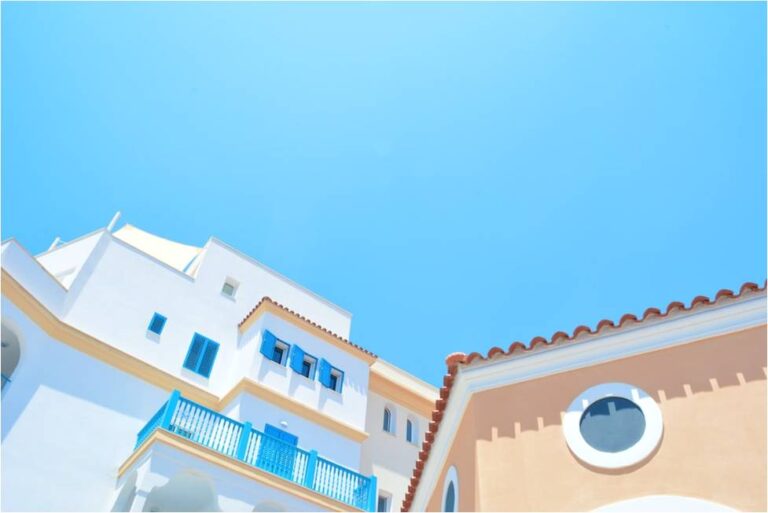
Prague, the Czech Republic’s capital, is brimming with attractions, especially historical ones. There are, however, a plethora of modern points of interest. The Prague Dancing House is one of them, a highly original structure that resembles and was inspired by two dancers – the immortally popular duo of Fred Astaire and Ginger Rogers.
The Nationale Nederlanden building, also known as the “Dancing House” or “Fred and Ginger,” is one of Prague’s most important landmarks and unquestionably the most internationally recognized piece of post-1989 Czech architecture. It has nearly 3000 square meters of office space, a restaurant, a gallery, and a conference center. Most notably, there is a sightseeing terrace on top from which you can gaze out over Prague’s stunning panorama. The two sections of the structure, aptly named ‘The Dancing House,’ distinctly resemble a pair of dancers. The building was built as an analogy of a feminine Ying, which balances a masculine Yang’ and is even nicknamed ‘Fred and Ginger’ in honor of dancers Ginger Rogers and Fred Astair (the legendary dancing couple from the 1930s).
The Dancing House is set on a historically significant plot. It was the site of a house that was destroyed by a US bombing at the end of World War II when the Allies bombed the area. It remained derelict and empty during the Communist rule of 1948-1949. The plot remained undeveloped until 1960 when it was eventually cleared. The plot next door belonged to Vaclav Havel’s family, who had lived there for nearly his entire life. In 1986, while still in the Communist period, a renowned architect by the name of Vlado Milunic developed an idea for a large project on the scene. He discussed it with his next-door neighbor, a Vaclav Havel dissident.
Havel rose to prominence and became the country’s leader during the Velvet Revolution, a nonviolent transfer of power from the Communist dictatorship in 1989. He was elected Czechoslovakia’s president and began to formulate ideas about what to do with the empty site. Eventually, he decided to have the renowned architect survey the site, to turn it into a cultural center. Because of the building that stands today, we know this was not the architect’s idea.
Nationale-Nederlanden, a Dutch insurance firm, agreed to fund the construction of a house on the controversial site. Milunic was chosen as the designer by the bank, and he was asked to collaborate with Frank Gehry, a well-known and respected Canadian-American architect. Thanks to the bank’s prowess and current financial situation, the funding for the project was substantial. The two architects met in Geneva in 1992 and started to brainstorm and edit the original concept into what would become the merging of static and dynamic themes, resulting in the interesting and multi-directional building we see today. The oddly shaped house, which is an example of deconstructivist architecture, is made of reinforced concrete and has 99 differently shaped adjoined facade panels. The frontispiece is made up of two towers that resemble a dancing couple. The Dancing House is topped by a dome known as “Medusa” due to its shape. The building has nine floors and asymmetrical spaces. The house extends across the street line and onto the sidewalk.
Deconstructivism is a post-modern architectural movement that emerged in the 1980s. This theme’s key feature is fragmentation, with no unity or consistency in the style. The theme also edits and transforms the surface skin, as well as employing non-rectilinear shapes that tend to distort angles and produce an odd sense of architecture. Another feature of this concept is ‘controlled chaos,’ which elaborates on the building’s juxtapositioned angles and curves. The ‘dancing’ form is made up of nearly 100 concrete panels of various shapes and sizes.
The structure is divided into two main sections in the center of the house. The first section is a glass tower supported by curved pillars, while the second has uneven moldings and crooked windows, which contribute to the chaotic theme. The protruding frames of the windows create a 3-D effect that shifts perspective. It is one of the most interesting houses designed in Prague at the end of the twentieth century. Jiiná is a well-known architect and interior designer who was born in southeastern Moravia in the Czech Republic. She attended the Prague Academy of Fine Arts, where she studied engineering and architecture before moving to London in 1968. She worked on the Brighton Marina for eight years before starting her own practice at the end of the 1980s. She rose to prominence in the mid-1980s, when she started designing retail stores, developing companies, and making connections.
Most of the interior of the Dancing House was designed by this British architect. Jiiná, the mind behind the asymmetric rooms and forms, laid out and built all 9 floors above ground and 2 floors underground. The commercial areas in the lobby and on the first floor are also asymmetric. The interior also includes six floors of office space, a restaurant on the ninth floor, and narrow, zigzagging hallways. Because of its uniqueness, the non-traditional design was a subject of discussion at the time it was completed. The house stands out among the historical structures known for their Baroque and Art Nouveau features. The fusion of Deconstructivism and Modernism differs greatly from the Gothic styles used in many of the houses and churches.
The Dancing House is now regarded as one of the most valuable postmodern buildings in Prague and an integral part of the Czech capital’s architecture, but it has not always been without controversy. The opponents of the building were persuaded that the Dancing House would not blend in with its surroundings since the majority of the buildings in the area were built in the Art Nouveau style.
There was also a lot of debate about the building’s irregular design, which gave the appearance that the towers were leaning. However, the Dancing House proved to be a true architectural gem of Prague, and it is difficult to find someone who does not like or accept it today.
The Ginger & Fred Restaurant, located on the 7th floor of the Dancing Building, is an upscale French restaurant. The view from the top is incredible. The high-up floor offers spectacular views of the Castle, Old Town, and Lesser Town. In the summer, you can sit on the terrace and enjoy a panoramic view of the city and surrounding areas. The bar on the building’s top floor offers fantastic cocktails and views of the red-roofed skyline.
The Dancing House Hotel offers stunning views of the Vltava River, as well as a restaurant, lounge, and an intricately crafted atmosphere. Each air-conditioned room has a flat-screen TV, a coffee machine, free WiFi, a private bathroom, and complimentary toiletries. You can use the 24-hour front desk service to ask some important questions and enjoy the hotel’s breakfast.
With a convenient location less than a mile from Charles Bridge and Wenceslas Square, staying in this one-of-a-kind accommodation is a once-in-a-lifetime opportunity that we highly recommend.
This one-of-a-kind structure was named Design of the Year by American Time magazine in 1996. The intriguingly shaped structure, dubbed the Ginger and Fred after Fred Astaire and Ginger Rogers, is meant to be reminiscent of a dancing couple. The beauty of the architecture, as well as the history behind its construction, inspired American Time to bestow this prestigious award on this structure. The general shape of The Dancing House was used on the national bank’s 2,000 Czech koruna coin. The coin is round gold and lifted on both sides. The coin weighs 6.22 grams, has a diameter of 20mm, a thickness of 1.55mm, and is worth 2,000 Kc.
The non-circulating coin has been in circulation since 2005. The currency is the Koruna, which has served as the medium of exchange since 1993. The coin’s engraver was Vladimir Oppl. On one hand, it says ‘DESET STOLET ARCHITEKTURY, 2000 K, ESK REPUBLIKA,’ and on the other, it says ‘SOUASNOST•TANC DM V PRAZE, 2005.’
Frank Gehry’s Dancing House, admired for his abstract and unorthodox works, would later serve as a guide to his construction of the Guggenheim Museum in Bilbao, Spain. The methods and techniques used here were test runs for the processes that were later incorporated into his designs. The massive curves for the facades were created by copying the aerodynamic spaces of airplanes and sports cars to improve airflow and reduce wind load. These curves were created using the same concepts and software that were used to design French jet aircraft.
By Shreya Patel, Vadodara, Gujarat


